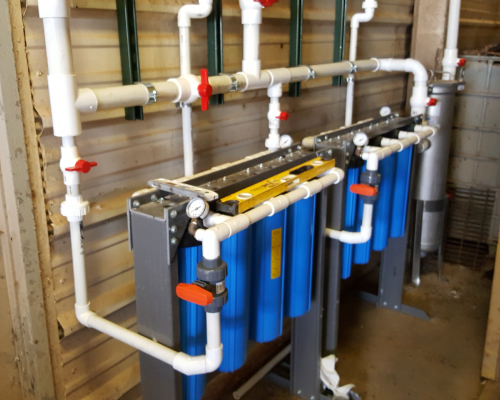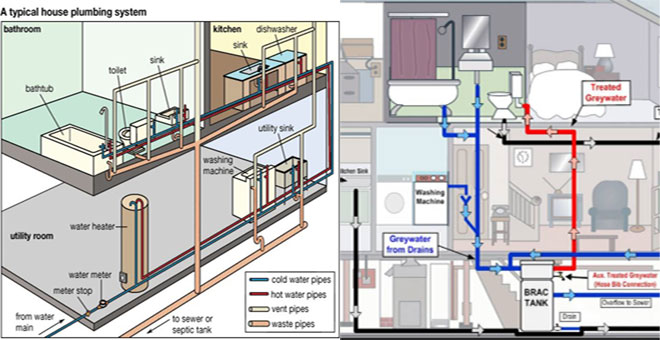An In-Depth Look at Your Property's Plumbing System Anatomy
An In-Depth Look at Your Property's Plumbing System Anatomy
Blog Article
The publisher is making several great annotation on Anatomy of a House: Understanding the Components as a whole in this content following next.

Understanding just how your home's plumbing system works is vital for every house owner. From delivering tidy water for drinking, food preparation, and bathing to securely eliminating wastewater, a well-maintained pipes system is essential for your family members's health and comfort. In this thorough overview, we'll discover the intricate network that comprises your home's pipes and deal suggestions on upkeep, upgrades, and managing usual issues.
Intro
Your home's pipes system is greater than just a network of pipes; it's a complicated system that ensures you have access to clean water and effective wastewater elimination. Recognizing its components and exactly how they work together can help you avoid expensive fixings and make certain everything runs smoothly.
Standard Components of a Plumbing System
Pipes and Tubing
At the heart of your plumbing system are the pipes and tubing that carry water throughout your home. These can be constructed from numerous products such as copper, PVC, or PEX, each with its benefits in regards to durability and cost-effectiveness.
Fixtures: Sinks, Toilets, Showers, etc.
Fixtures like sinks, bathrooms, showers, and tubs are where water is utilized in your home. Comprehending exactly how these fixtures connect to the pipes system assists in identifying issues and preparing upgrades.
Valves and Shut-off Points
Valves regulate the flow of water in your plumbing system. Shut-off valves are important throughout emergency situations or when you require to make repair work, enabling you to separate parts of the system without interrupting water circulation to the entire home.
Supply Of Water System
Main Water Line
The major water line links your home to the community water supply or an exclusive well. It's where water enters your home and is dispersed to numerous fixtures.
Water Meter and Pressure Regulator
The water meter measures your water usage, while a stress regulator makes sure that water flows at a secure stress throughout your home's plumbing system, stopping damage to pipelines and fixtures.
Cold Water vs. Warm water Lines
Comprehending the distinction in between cold water lines, which provide water directly from the primary, and hot water lines, which carry warmed water from the water heater, helps in troubleshooting and planning for upgrades.
Water drainage System
Drain Pipes Pipes and Traps
Drain pipelines bring wastewater away from sinks, showers, and commodes to the drain or sewage-disposal tank. Traps protect against sewer gases from entering your home and also catch debris that might trigger clogs.
Air flow Pipes
Air flow pipelines enable air right into the drain system, stopping suction that might slow drain and cause catches to vacant. Proper air flow is necessary for keeping the stability of your pipes system.
Relevance of Appropriate Drainage
Guaranteeing appropriate water drainage protects against backups and water damage. Frequently cleaning up drains pipes and maintaining traps can avoid costly repairs and expand the life of your plumbing system.
Water Heating Unit
Sorts Of Hot Water Heater
Hot water heater can be tankless or traditional tank-style. Tankless heaters warmth water on demand, while containers store warmed water for immediate use.
Updating Your Pipes System
Factors for Upgrading
Upgrading to water-efficient components or replacing old pipes can enhance water top quality, minimize water costs, and enhance the worth of your home.
Modern Pipes Technologies and Their Advantages
Explore innovations like clever leakage detectors, water-saving commodes, and energy-efficient water heaters that can save money and lower environmental effect.
Price Factors To Consider and ROI
Compute the upfront expenses versus lasting savings when thinking about pipes upgrades. Numerous upgrades spend for themselves through minimized energy bills and less fixings.
Just How Water Heaters Attach to the Plumbing System
Comprehending just how water heaters connect to both the cold water supply and warm water circulation lines aids in detecting concerns like insufficient hot water or leaks.
Upkeep Tips for Water Heaters
Regularly purging your hot water heater to get rid of sediment, checking the temperature setups, and inspecting for leaks can prolong its life expectancy and improve energy performance.
Usual Plumbing Issues
Leakages and Their Causes
Leakages can take place as a result of maturing pipelines, loose installations, or high water stress. Attending to leaks quickly avoids water damage and mold and mildew development.
Obstructions and Obstructions
Blockages in drains and toilets are often brought on by purging non-flushable products or a buildup of grease and hair. Making use of drain screens and bearing in mind what drops your drains can prevent clogs.
Indicators of Pipes Issues to Watch For
Low tide pressure, slow drains, foul odors, or abnormally high water expenses are signs of possible plumbing problems that must be attended to immediately.
Plumbing Upkeep Tips
Routine Evaluations and Checks
Set up yearly plumbing examinations to capture problems early. Search for indicators of leaks, corrosion, or mineral accumulation in faucets and showerheads.
Do It Yourself Upkeep Tasks
Easy jobs like cleansing faucet aerators, looking for toilet leakages making use of dye tablets, or protecting exposed pipelines in cold environments can avoid major plumbing concerns.
When to Call an Expert Plumber
Know when a pipes problem calls for specialist knowledge. Trying complex fixings without proper expertise can lead to even more damage and greater repair expenses.
Tips for Lowering Water Use
Simple habits like fixing leaks quickly, taking shorter showers, and running complete lots of washing and meals can preserve water and reduced your utility expenses.
Eco-Friendly Pipes Options
Consider sustainable pipes materials like bamboo for floor covering, which is durable and environmentally friendly, or recycled glass for kitchen counters.
Emergency Readiness
Steps to Take Throughout a Plumbing Emergency
Know where your shut-off shutoffs lie and how to switch off the water supply in case of a burst pipeline or major leak.
Relevance of Having Emergency Calls Convenient
Keep get in touch with details for local plumbers or emergency solutions conveniently offered for quick feedback during a plumbing situation.
Environmental Influence and Conservation
Water-Saving Components and Home Appliances
Installing low-flow faucets, showerheads, and commodes can substantially reduce water usage without compromising efficiency.
DIY Emergency Fixes (When Suitable).
Temporary fixes like using duct tape to spot a leaking pipeline or positioning a pail under a trickling tap can decrease damages until an expert plumbing technician gets here.
Verdict.
Comprehending the composition of your home's plumbing system empowers you to preserve it efficiently, saving money and time on repair work. By adhering to routine maintenance routines and remaining educated regarding contemporary pipes innovations, you can ensure your plumbing system runs efficiently for many years ahead.
The Anatomy of Your Home s Plumbing System
Understanding the anatomy of your home s plumbing system is essential for any homeowner. It not only helps in identifying potential issues but also facilitates effective communication with professionals when repairs or upgrades are needed. Your home s plumbing system is more than just pipes and faucets; it s a complex network that ensures the efficient and hygienic flow of water in and out of your house. In this blog, we ll dissect the crucial components of your home s plumbing system. For those in Antelope Valley, Brock Plumbing is your trusted partner for all your plumbing needs, ensuring your system functions smoothly and efficiently.
Water Supply System
Main Water Line: This is where your home s plumbing system begins. The main water line connects your home to the public water supply or a private well. Pipes and Shut-off Valves: Pipes distribute water throughout your home. Shut-off valves are crucial for controlling the flow of water and making repairs without shutting off the entire system. Drainage System
Drain Pipes: These pipes carry waste and water away from sinks, toilets, and showers. Vents: Vents allow sewer gases to escape and help maintain proper pressure in the drainage pipes, ensuring efficient flow of wastewater. Traps: Every fixture has a trap, a U-shaped pipe that holds water and prevents sewer gases from entering your home. The most common is the P-trap under sinks. Fixtures and Appliances
Fixtures and appliances are the most interacted with parts of your plumbing system. They include sinks, toilets, showers, dishwashers, and washing machines. Each fixture and appliance has its own supply and drainage connection, ensuring they receive clean water and can dispose of wastewater effectively.
Water Heating System
Your water heater is a crucial component, providing hot water to various fixtures and appliances in your home. It can be tank-based or tankless, with each type having its own set of advantages and maintenance requirements. Regular maintenance is essential to ensure efficient operation and extend the lifespan of the unit.
Sump Pump
In areas prone to flooding or with high water tables, a sump pump is an essential part of the plumbing system. It s installed in the lowest part of your basement or crawlspace and pumps out water that accumulates, preventing flooding and protecting your home from water damage.
Septic System
Homes that are not connected to a municipal sewer system have a septic system and an underground wastewater treatment structure. Understanding how to maintain your septic system is crucial to prevent backups, odors, and early system failure.
Conclusion
Your home s plumbing system is a complex and essential network, ensuring the efficient and hygienic flow of water in and out of your property. Understanding its key components helps in maintaining it properly and identifying issues before they escalate into major problems. For residents in Antelope Valley, Brock Plumbing is dedicated to providing top-notch services, ensuring that every part of your plumbing system is in perfect working order. Trust our team of professionals to handle all your plumbing needs, ensuring your home remains comfortable, safe, and well-maintained.
https://brockplumbinganddrains.com/blog/the-anatomy-of-your-homes-plumbing-system/

As a fervent person who reads on , I assumed sharing that excerpt was smart. Make sure you take the opportunity to distribute this write-up if you enjoyed reading it. We recognize the value of reading our article about Plumbing Installation 101: All You Need to Know.
Click Here Report this page